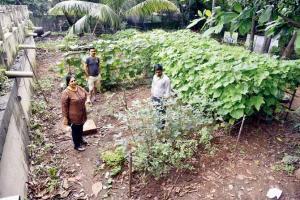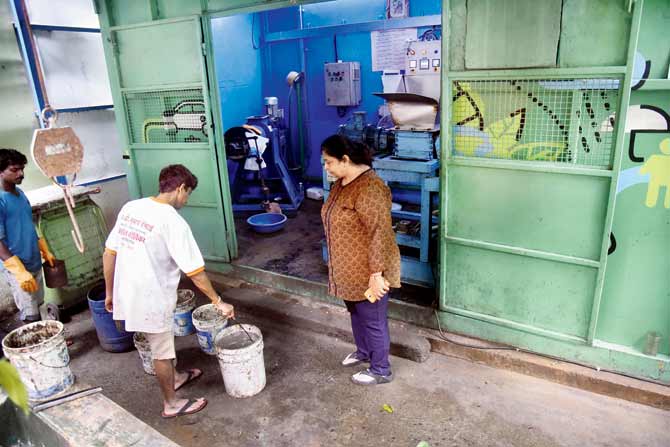Residents create garden to grow veggies from wet waste from 100 buildings and some restaurants

The garden that Pali Hill residents tend with some help from BMC's gardeners. Pic /Pradeep Dhivar
Even as the city struggles with managing household waste, Pali Hill residents have shown just how well it can be done. The residents' unique initiative has now produced two-and-a-half kg of a variety of vegetables that will be donated to an old people's home next week. The waste-to-energy initiative also lights up 70 streetlights in the area.
ADVERTISEMENT
Last year, the society installed a waste-to-energy plant with help from Brihanmumbai Municipal Corporation (BMC) which processes a tonne of garbage and the plant produces 300 kg of manure every week.
Also Read: BMC's recycling for plastic bid gets dry response
"We started with using the biogas to light up streetlights in the area. We then started composting in October last year and decided to use the nutrient-rich manure to grow vegetables," said Madhu Poplai, secretary of the Pali Hill Residents Association (PHRA).
The kitchen garden produces brinjal, bottle gourd, okra, spinach, green chillis and potatoes. "The plants yielded the first batch of vegetables last week. We have been in talks with an orphanage and an old age home. We will donate the vegetables to one of them next week," said Poplai.
Apart from vegetables, the residents have also planted papaya trees and two of them have already borne fruit. Poplai said that they gave the first batch of fruits to the guards and helpers in the societies and will donate the fruits in the future as well.
The vegetable patch is cared for by PRHA's garden team which comprises five residents, Sanchali Sarkar, Tulip Mahadeval, Sushma Kothari, Rati Banagee and Manju Malhotra. Sarkar said, "We have planted seasonal vegetables and we work with the BMC's gardeners. We conduct routine visits to ensure that the plants are cared for well."
Also Read: BMC proposes ALMs to be roped in for waste management
 The waste-to-energy plant that the Pali Hill Residents Association installed last year. Pic/ Pradeep Dhivar
The waste-to-energy plant that the Pali Hill Residents Association installed last year. Pic/ Pradeep Dhivar
A civic official from H West ward said that earlier plots measuring between 50-100 square metres near the Pali Hill reservoir were lying barren. "The plants are currently occupying two of the plots and after the monsoon, we will extend the vegetable patch to the other plot as well," he said.
Poplai added that their aim was to be able to produce enough vegetables so that they can donate on a weekly basis. While the residents started planting the trees three months ago, the heavy rain in June and July almost destroyed the vegetables. But, they were able to revive them.
Also Read: Mumbai: BMC to set up ward-level CCTV to monitor Illegal dumping of waste
Poplai said the waste-to-energy plant processes around 800-850 kg of wet waste from a lot of 78 buildings and 23 bungalows that are part of the association as well as 150-200 kg of waste from 6-7 restaurants including Pali Bhavan, Pali Village Cafe, Khanekhas, Mini Punjab and Nom-Nom among others. The BMC garbage compactors pick up the waste and drop it off at the plant.
300 kg
Amount of manure waste-to-energy plant produces every week
78
No. of buildings that send their waste
23
No. of bungalows that the waste comes from
Catch up on all the latest Mumbai news, crime news, current affairs, and also a complete guide on Mumbai from food to things to do and events across the city here. Also download the new mid-day Android and iOS apps to get latest updates
 Subscribe today by clicking the link and stay updated with the latest news!" Click here!
Subscribe today by clicking the link and stay updated with the latest news!" Click here!






